- 7 Top Flite Golf Clubs XL for Improved Performance - September 28, 2024
- Top Flite Golf Clubs: Top 5 Reasons to Choose Them - September 28, 2024
- Top 3 Golf Club Fitters for a Perfect Swing - September 28, 2024
When it comes to chipping like a pro, selecting the right club is critical, as it directly impacts your ability to control trajectory, spin, and roll, ultimately determining how close you get to the hole. For pitch shots, a 52-degree wedge offers a balance of height and roll, while a 56-degree wedge provides a higher trajectory and more spin. Hybrids can be a forgiving alternative, especially for slower swing speeds. Putter chips are ideal for short distances, maintaining control and precision. To master chipping, you'll need to take into account grain, slope, distance, and contour factors – and there's more to explore in perfecting your technique.
Key Takeaways
- Select the right wedge for chipping, considering trajectory, spin, and roll, to get the ball close to the hole.
- Hybrids offer a forgiving alternative to traditional wedges, with a larger sweet spot and wider sole for tight lies and hardpan.
- Putter chips are effective for short distances, maintaining control and precision, and are ideal within 10-15 feet of the green.
- Grain and slope considerations are crucial, requiring careful observation to adjust swing and clubface alignment for a consistent roll.
- Clubhead speed control is vital for achieving ideal distance and contour control, and can be regulated through swing tempo, ball position, and wrist firmness.
Wedge Selection for Chipping
Selecting the right wedge for chipping is essential, as it allows you to control trajectory, spin, and roll, ultimately determining how close you get to the hole.
When it comes to club selection, you'll want to weigh the situation and desired ball behavior. For a pitch shot, a 52-degree wedge is a popular choice, offering a balance of height and roll. However, if you need a higher trajectory and more spin, a 56-degree wedge might be the better option. On the other hand, if you're faced with a tight lie and need a bump-and-run shot, an 8 iron could be the way to go.
Developing a system that works for you through practice and experimentation is vital. You might find that the 'clock system' works best, where you use one club with varying swing lengths to control distance. Or, you might prefer the 'interval system', which involves using two or three clubs with different swings to achieve the desired result.
Whatever your approach, mastering club selection is key to chipping like a pro. By choosing the right lofted wedge for the job, you'll be able to execute shots with precision and confidence, getting you closer to the hole with every chip.
Hybrids for Chipping Situations
When faced with chipping situations that demand a higher trajectory and more spin, you can effectively turn to hybrids, which offer a unique set of benefits that make them an attractive alternative to traditional wedges.
With a larger sweet spot than traditional wedges, hybrids are more forgiving for chipping, especially for golfers with slower swing speeds. This means you'll have more room for error when taking a chip shot.
The wider sole of a hybrid also helps prevent digging into the ground, making it easier to chip from tight lies or hardpan.
Hybrids can be used to chip from a variety of distances, from just off the green to 20-30 yards away, depending on the loft and swing speed.
Additionally, some golfers prefer using a hybrid for chipping because it allows them to maintain a more consistent swing and ball position, whereas traditional wedges may require more manipulation and adjustment.
Putter Chips: When to Use
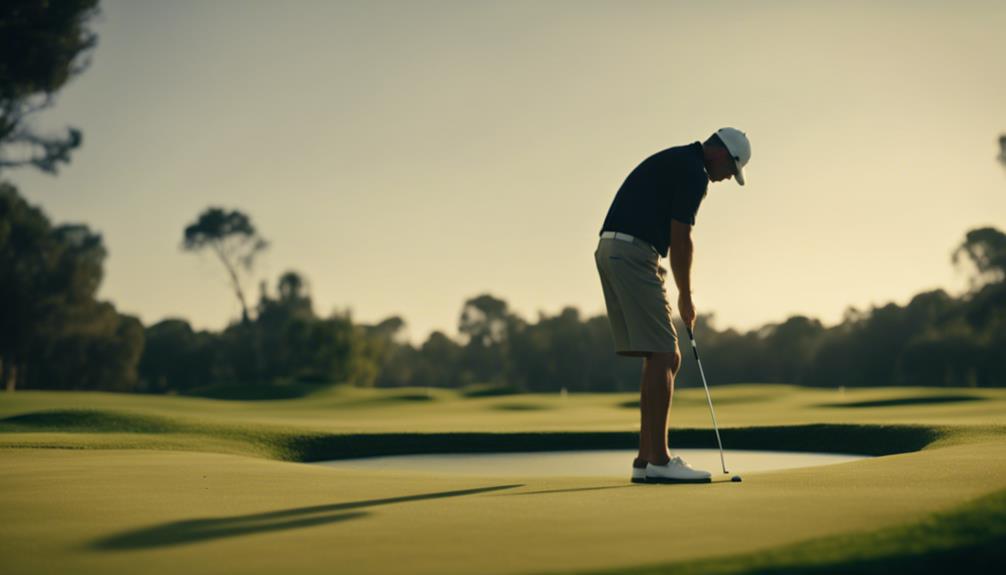
When you're faced with a short distance chip, you'll want to think about using a putter chip to maintain control and precision.
This shot is particularly useful when you need to stop the ball quickly, as it allows you to roll the ball onto the green with a consistent speed and direction.
In situations where high-arc shots aren't necessary, the putter chip is an effective option to get the ball close to the hole.
Short Distance Control
To master short distance control, you'll find that putter chips are an essential shot to have in your arsenal, particularly when you're faced with a tight lie or an unobstructed path to the hole.
This low-running shot is ideal for situations around the green where a bump and run is the best option.
When deciding whether to use a putter chip, consider the following factors:
Distance to the hole: Putter chips are most effective within 10-15 feet of the green.
Slope and grain of the green: Take into account the green's slope and grain to determine the amount of friction needed to stop the ball quickly.
Type of lie: Tight lies are perfect for putter chips, as they allow for a smooth, consistent roll.
Green speed: Slower greens are better suited for putter chips, as they require less speed and more control.
High-Arc Shots Needed
You'll need to switch to a higher-arcing shot when the situation demands more clearance, such as when you're faced with a taller grass, deeper rough, or a more pronounced slope between your ball and the hole.
In these situations, a putter chip won't provide enough height to clear the obstacle, and you'll need to opt for a higher-lofted club to get the ball out of trouble.
This is where your pitching wedge or sand wedge comes into play.
These clubs are designed to produce higher-arcing shots with more spin, allowing you to clear obstacles and stop the ball quickly on the green.
When choosing between a pitching wedge and a sand wedge, consider the height and distance you need to cover.
If you need to clear a longer distance or a taller obstacle, a sand wedge might be the better option.
With practice and experience, you'll develop a sense of when to use each club to achieve the desired trajectory and spin.
Grain and Slope Considerations
As you prepare to chip, grain and slope considerations become vital, requiring careful observation to adjust your swing and clubface alignment accordingly.
When playing around the greens, understanding how grain and slope interact with your ball's movement is paramount. Grain direction can greatly affect the roll, making it slower or faster depending on whether you're rolling as the grain or against it.
To compensate for grain and slope, consider the following adjustments:
Clubface alignment: Align your clubface to match the slope and grain direction to produce a consistent roll.
Swing speed: Increase or decrease your swing speed to counteract the effect of grain and slope on the ball's movement.
Angle of attack: Alter your angle of attack to accommodate the slope, taking into account how it will affect the ball's trajectory.
Wedge selection: Choose the right degree wedge for the shot, considering the slope and grain to guarantee the correct height and spin.
Distance and Contour Factors
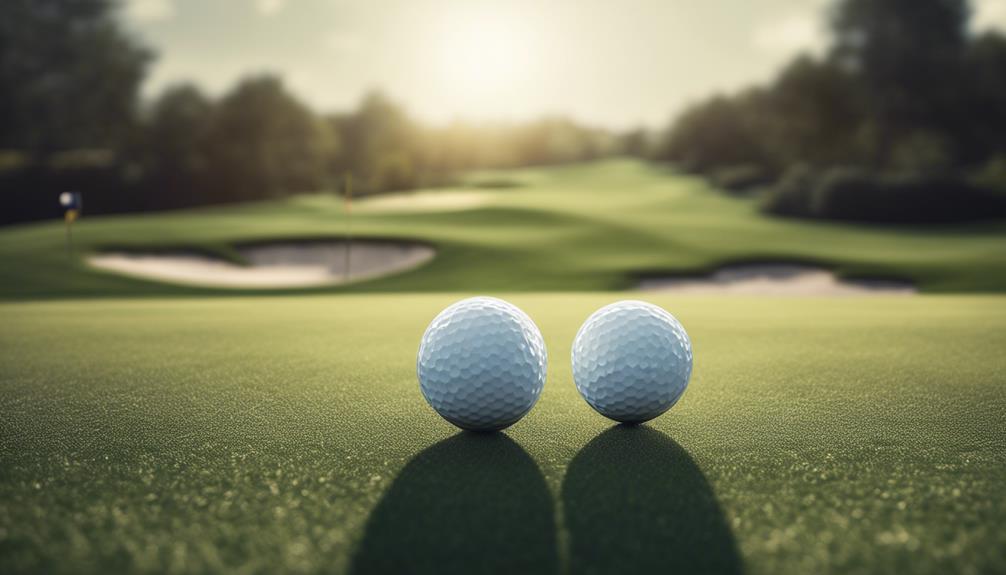
When you're faced with a chip shot, you need to assess the distance to the pin and the green's contour to select the right club.
Now, it's time to fine-tune your club selection by controlling clubhead speed, choosing the ideal loft and bounce angles, and accurately reading the green's contour.
Clubhead Speed Control
Precise regulation of clubhead speed is essential for achieving ideal distance and contour control, as even slight variations can profoundly impact the trajectory and roll of your chip shots. When you strike the ball with the right clubhead speed, you can control the distance it travels and the contour it takes, allowing you to navigate challenging greens with confidence.
Key factors in regulating clubhead speed include:
Swing tempo: A consistent swing tempo helps you maintain a consistent clubhead speed, ensuring more predictable results.
Ball position: Experiment with different ball positions to find the sweet spot that allows you to strike the ball with the desired clubhead speed.
Wrist firmness: Controlling wrist firmness helps you regulate clubhead speed, allowing for a more precise strike.
Practice: Regular practice helps you develop a feel for the right clubhead speed, allowing you to make adjustments on the fly.
Loft and Bounce Angles
You'll need to take into account the loft and bounce angles of your golf club to masterfully control the distance and contour of your chip shots, as these critical factors profoundly impact the trajectory and roll of the ball.
The loft angle affects the height and distance of your chip shot, with higher loft angles resulting in higher shots with less roll. On the other hand, the bounce angle influences how the club interacts with the ground, providing more forgiveness and less digging with increased bounce.
When chipping from tight lies or uphill slopes, a higher loft angle and less bounce are suitable, while a lower loft angle and more bounce are better for chipping from thick rough or downhill slopes.
The ideal loft and bounce angles for chipping vary depending on your swing style, course conditions, and shot requirements. A 56-degree wedge with 12-14 degrees of bounce is a versatile club, offering a good balance between height and roll.
Consider your club face's loft and bounce angles to optimize your chip shots and improve your overall game.
Green Contour Reading
As you prepare to chip like a pro, understanding how to read the green's contour is essential, since it directly affects the ball's roll and ultimately, the success of your shot.
To accurately read the green contour, you need to examine two key factors: distance and contour.
Distance Factors:
- Length of the chip shot: Longer shots require more break than shorter shots.
- Rolling distance: The ball's roll is affected by the slope and undulation of the green, with a 1% slope translating to about 1 foot of break per 10 feet of roll.
When reading the green contour, you should also look for visual cues such as the direction of the grass grain, the color and texture of the grass, and the location of water hazards and bunkers.
By accurately reading the green contour, you can choose the right club and play the shot with confidence. Remember, even slight miscalculations can result in missed putts.
Practice on different types of greens and develop a pre-shot routine that includes reading the green contour to improve your skills.
With mastery of green contour reading, you'll be chipping like a pro in no time.
Adapting to Course Conditions
When taking on a new course, understanding how to adapt to its unique conditions is essential, since every links-style, parkland, or other layout presents distinct challenges that demand tailored club selection and technique adjustments.
You'll need to examine the course conditions, including rough height and apron design, which can favor certain types of shots and influence your club selection. For example, taller rough and tighter aprons may require higher-lofted clubs and more precise shots.
On fast and hard greens, you may need to opt for slower clubs and more controlled spin to achieve the desired result.
Links-style courses, with their tighter lies, firmer surfaces, and stronger winds, often demand a different approach than parkland courses. You'll typically need to use lower-lofted clubs and focus on more running shots to succeed.
By adapting to these course conditions, you'll be able to adjust your club selection and technique to suit the specific demands of the course. This ability to adapt is critical to effective chipping and will help you perform more consistently across various courses.
Lie and Club Face Angle
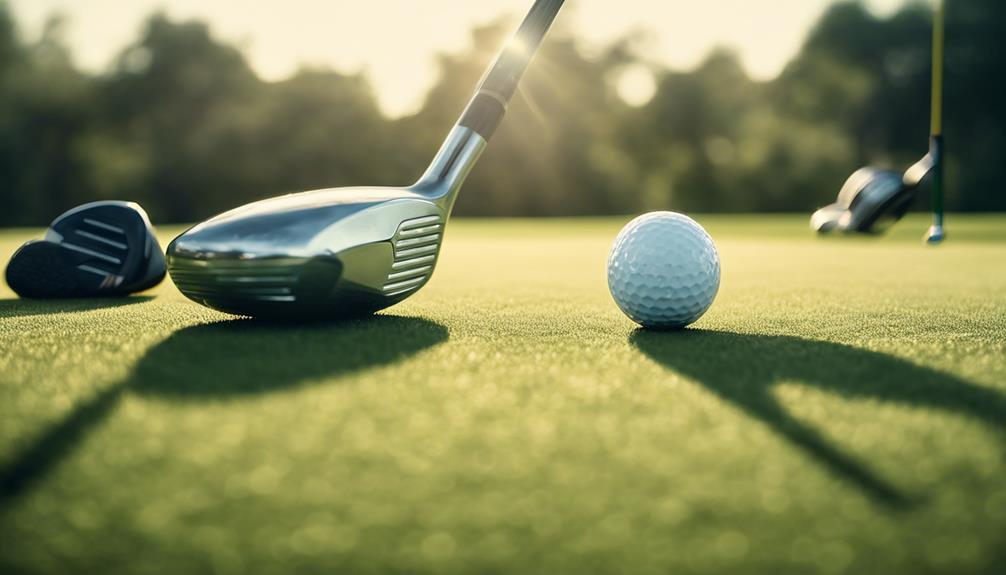
During setup, pay attention to the lie of the ball and the club face angle, as these two factors greatly impact the trajectory and distance of your chip shot. A slight misalignment can result in a shot that's off-target or lacks the desired height.
To master the chip shot, you need to understand how to adjust your club face angle to match the lie of the ball.
Uphill lie: Close the club face slightly to facilitate the ball popping up quickly and clearing any obstacles.
Downhill lie: Open the club face slightly to reduce the loft and allow the ball to roll further.
Sidehill lie: Adjust the club face angle to compensate for the slope, guaranteeing the ball flies straight and true.
Firm lie: Use a slightly closed face to pitch the ball with a lower trajectory and more spin.
Chipping From Different Lies
By adapting your club selection and technique to the specific lie, you'll be able to chip with precision and control, no matter the situation.
When faced with a tight lie, you'll want to opt for a lower-lofted club like a 7-iron or 8-iron to minimize the risk of digging into the ground. On the other hand, a fluffy lie calls for a higher-lofted club, such as a 56-degree or 60-degree wedge, to get the ball out quickly and avoid digging.
Downhill lies require a club with more loft and a steeper angle of attack to prevent the ball from rolling too far.
Conversely, uphill lies demand a club with less loft and a shallower angle of attack to prevent the ball from flying too high and rolling too far.
When chipping from a sidehill lie, it's essential to align the clubface with the slope to prevent the ball from curving excessively.
Ball Position and Alignment
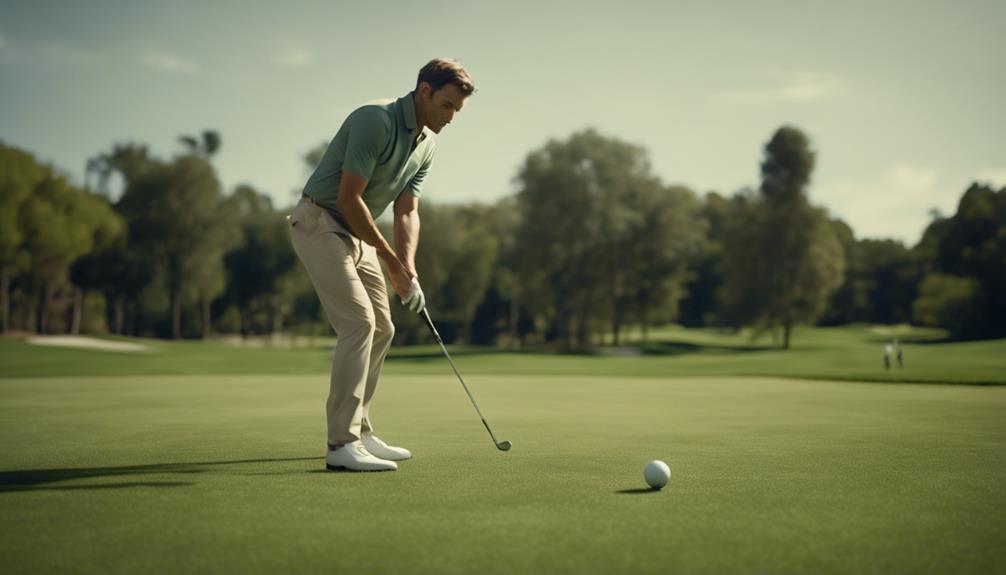
As you set up for a chip shot, you'll want to focus on three key elements: your stance and body angle, ensuring your clubface is aligned properly, and maintaining a balanced weight distribution.
These factors are essential in determining the trajectory and distance of your shot.
Stance and Body Angle
To establish a consistent and reliable chipping technique, you'll need to adopt a narrow and open stance, with your feet positioned slightly wider than shoulder-width apart and your weight evenly distributed between both feet. This setup allows for better balance and control throughout the swing.
In terms of body angle, you should lean slightly forward, keeping your shoulders and chest pointing towards the target. This helps maintain balance and generates a smooth, controlled motion throughout the chipping swing.
Narrow and open stance: Feet positioned slightly wider than shoulder-width apart.
Even weight distribution: Weight evenly distributed between both feet.
Forward body angle: Shoulders and chest leaning forward to maintain balance and control.
Relaxed posture: A slight bend in the knees and a relaxed posture to generate a smooth motion.
Clubface Alignment Check
With your stance and body angle established, you can now focus on positioning the ball and aligning the clubface to guarantee a straight chip shot.
For ideal results, place the ball centered or slightly forward in your stance. Next, make certain the clubface is aligned directly at the target.
To double-check your clubface alignment, place a club or alignment stick on the ground parallel to the target line, making sure the clubface is square to it. This vital step helps prevent an open or closed clubface, which can result in a curved shot that's difficult to control.
You can also use a string or laser alignment tool for a more precise visual representation.
To improve your consistency, practice with a mirror or video recording to develop a pre-shot routine that verifies accurate clubface alignment. By mastering this step, you'll be able to chip the ball with confidence, using the right club to use for the shot.
Weight Distribution Balance
You'll achieve a consistent chip shot by mastering weight distribution balance, which relies on precise ball positioning and alignment to maintain control throughout the swing.
To optimize your weight distribution, focus on the following key elements:
- Weight distribution: Aim for 60-70% of your weight on your left foot and 30-40% on your right foot as a right-handed golfer.
- Ball position: Place the ball just forward of the center of your stance to promote a descending blow and increased control.
- Alignment: Verify that your feet, knees, and shoulders are aligned parallel to the target line for a straight shot.
- Hand and wrist alignment: Maintain a slight forward press of your hands and wrists at address to promote a consistent weight distribution and smooth swing.
Club Speed and Swing Control
Mastering club speed and swing control is key to revealing a consistent and precise short game, as even slight variations in speed can profoundly impact the trajectory and distance of your chip shots. To achieve consistent club speed, focus on making a smooth, controlled backswing and shift, avoiding any jerky or abrupt movements that can disrupt the flow of the swing.
| Club Speed | Trajectory | Distance |
|---|---|---|
| Slower (20-25 mph) | Higher | Shorter |
| Medium (25-30 mph) | Neutral | Ideal |
| Faster (30-40 mph) | Lower | Longer |
Reading Greens for Better Chips
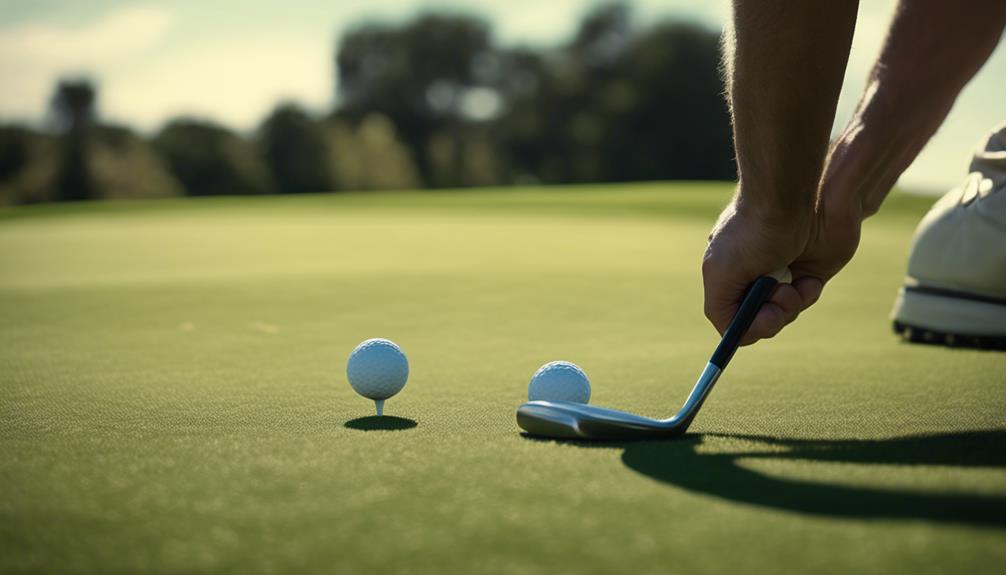
Accurate green reading is essential for executing effective chip shots, as it enables you to anticipate the ball's behavior and adjust your swing accordingly.
When you're able to read the greens correctly, you can predict how the ball will roll and hit the target with precision.
To improve your green reading skills, focus on the following key factors:
Slope: Identify the direction and severity of the slope to determine how the ball will break.
Grain: Consider the type of grass and its direction to anticipate how it will affect the ball's roll.
Speed: Assess the pace of the green to determine the ideal speed for your chip shot.
Undulations: Study the green's contours to anticipate how the ball will react to subtle changes in elevation.
Practice Drills for Mastery
To refine your chipping skills, incorporate targeted practice drills into your training routine, focusing on tempo, distance control, adaptability, accuracy, and mental toughness.
Start by practicing with a metronome to develop a consistent chip shot tempo, aiming for 24-27 beats per minute.
Next, try the 'clock drill' to improve distance control, chipping with different clubs at different distances, such as 3 o'clock for a 7-iron and 5 o'clock for a 9-iron.
The 'ladder drill' will help you master club selection and adaptability, chipping from different lies like uphill, downhill, and sidehill.
To enhance accuracy and direction control, try the 'target drill', chipping to specific targets like a cup or a flag.
Finally, test your mental toughness and decision-making with the 'pressure drill', chipping in simulated game situations like from a tight lie or with a challenging pin position.
Frequently Asked Questions
What Club Should I Use to Chip?
When deciding what club to use to chip, you're considering club selection, swing style, and ball position; assess the lie, distance, and pin proximity to choose the right club, factoring in your personal swing style and desired ball behavior.
How Do You Chip Like a Pro Golfer?
To chip like a pro, you adjust your stance depending on the slope, position the ball centered or forward, and develop a consistent practice routine to refine your technique, ensuring a repeatable motion and precise control.
What Club Does Tiger Woods Chip With?
You'll notice Tiger Woods frequently relies on his 60-degree lob wedge, one of Tiger's favorites, for most greenside shots, but he also employs his 56-degree wedge and occasionally a 9-iron, adapting Woods' wedge selection to suit his tactics and the situation.
What Degree Wedge Do Pros Chip With?
You'll find that pros typically opt for a 58- or 60-degree wedge loft, aligning with tour preferences, which provides a high bounce angle, allowing for precise control and trajectory management, perfect for executing pinpoint chip shots.
Conclusion
As you refine your chipping skills, remember that precision is key.
It's like a surgeon wielding a scalpel – one slight miscalculation can lead to disaster.
A study by the PGA found that pros average 11.4 feet from the hole on chip shots, while amateurs average 18.5 feet.
Mastering the right clubs, techniques, and reads can help you narrow that gap.
By following these guidelines, you'll be well on your way to chipping like a pro, and your scores will reflect it.




